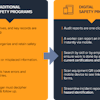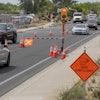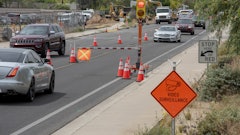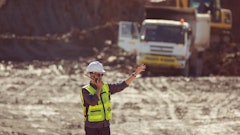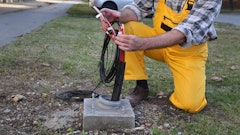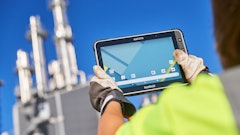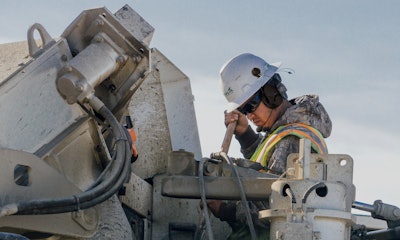
A construction site has many moving parts, with active heavy equipment and work vehicles coming and going. Workers want to know that they are heard, seen and safe. This is why worksite communication plays a vital role in worker safety.
Unfortunately, communication between workers is made difficult by the distances involved and a noisy environment. Often, workers resort to communicating with a crane operator or backhoe operator via hand signals.
Typically, work crews communicate with operators, drivers and other workers using two-way radios. However, construction company managers are discovering an alternative technology based on long-range Bluetooth signals. This article compares the use of radios with new communication headsets, such as those using Sena's proprietary Mesh Intercom protocol, and the implications for worker safety and productivity.
When evaluating new communication technology, managers should consider range, clarity, worker safety, OSHA compliance and cost.
Distance Matters
The site may be miles long. Radios work well over these distances. Bluetooth communications are limited to about half a mile, but Mesh Bluetooth technology enables each headset to act as a node, relaying the signal to the next headset, extending the range. Mesh network adapters can act as repeaters, extending the range farther, and connect to mobile phones beyond the worksite. If a driver leaves the coverage area, the headset will automatically reconnect when the driver reenters.
Cut the Chatter
Two-way radios use air time in a radio frequency band that it is a public band shared with other users. It’s not uncommon to experience cross talk from people outside the team. To avoid hearing the chatter of other users, workers try switching to different channels.
Mesh headsets use a higher frequency band of around 2.4 GHz. While this band is shared with Bluetooth-enabled devices, its use is unlikely to encounter outside chatter. In any case, Mesh technology allows multiple channels of communication, including the ability to set up multiple groups within the network. Workers can have private conversations.
Better Communication
Radios are half-duplex, which means only one person can talk at a time after pushing a button. Sometimes this can lead to understanding only half of what has been said. In contrast, a Mesh headset is full-duplex, allowing multiple people to speak at the same time, similar to a phone call. No button pushing is required.
This brings up a safety issue. When traffic is passing at 60 mph, seconds count. The time it takes to push a button on a radio could take too long to warn a coworker. Using a Mesh system, there is no delay. What’s more, workers can continue to use both hands, another safety consideration.
Cancel the Noise
 Mesh headsets can be worn over the head or attached to hard hats/helmets. New helmets, like this one from Jannatec, have integrated Sena Mesh communication headsets.Sena Industrial
Mesh headsets can be worn over the head or attached to hard hats/helmets. New helmets, like this one from Jannatec, have integrated Sena Mesh communication headsets.Sena Industrial
In addition, ear-muff style headsets are available that provide worker hearing protection. The clamor of concrete saws and jackhammers can be mitigated by 20 to 26 dB at the same time communication is enabled. OSHA guidelines require employers to provide hearing protection for workers exposed to 85 dB over an eight-hour workday (or 8-hour weighted time average). Headsets with integrated hearing protection enables companies to be in compliance.
Worker adoption of PPE is an age-old problem. The boss may hand out hearing protection equipment, but it is up to the worker to use it. If workers like using communication headsets, it is more likely they will get the accompanying hearing protection, but even that may not assure adoption.
New safety helmets are emerging that have integrated Mesh communication headsets. Workers don’t have to install the headset on their hard helmets, and there is only one piece of equipment to remember to bring to the jobsite.
Cost Control
The final consideration is cost. A construction company must pay for radio air time, and sometimes it doesn’t want to pay for multiple channels. Instead, managers give workers walkie-talkies purchased at a sporting goods store. These may save money, but they have limited range and quality.
Conclusion
Communications technology impacts cost, safety and productivity. Two-way radios definitely have advantages in terms of range and familiarity. Nevertheless, road construction managers are considering alternative technology for connecting the jobsite.
Chris Clarke is an industrial communications consultant at Sena Industrial.
